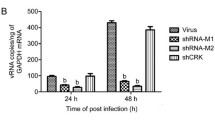Abstract
Two approaches have been developed to construct plasmids that mediate RNA interference to inhibit the replication and expression of HBV in 2.2.15 cell. The overlapping PCR extension and restriction enzyme-digestion were used to generate DNA fragments encoding designed shRNA based on sequences of ORF C of HBV genome. The pU6 derived vectors were constructed to develop plasmid based shRNA delivery systems termed pU6/HBVi. There were significant reductions in the expression of HBsAg and HBeAg between cells transfected with pU6/HBVi and control groups (as to HBsAg: P < 0. 01; and HBeAg: P < 0. 01). Consistently, the HBV DNA copies were reduced from 2.71 × 107 to <5 × 102 copies with or without pU6/HBVi. These results suggested that shRNA delivery by recombinant plasmids harboring shRNA encoding DNA fragment of interest generated either by overlapping PCR extension or restriction enzyme-digestion, could inhibit expressions of viral proteins and reduce viral replications. The pU6 derived plasmids might be a useful shRNA delivery system in mammalian cells. In addition, we found siRNA based on stealth 2311 was a potent RNAi target of HBV genome.




Similar content being viewed by others
References
Hannon GJ (2002) RNA interference. Nature 418:244–251
Matzke Marjori, Matzkz AJ, Kooter JM (2001) RNA: Guiding gene silencing. Science 293:1080–1083
Haasnoot J, Berkhout B. (2006) RNA interference: its use as antiviral therapy. Handb Exp Pharmacol 173:117–150
Nishitsuji H, Kohara M, Kannaqi M, Masuda T (2006) Effective suppression of human immunodeficiency virus type 1 through a combination of short- or long-hairpin RNAs targeting essential sequences for retroviral integration. J Virol 80:7658–7666
Gao Y, Sun L, Dong J, Xu X, Shu Y, Chen M, Yin L, Liang Z, Jin Q (2006) Rapid identification of small interfering RNA that can effectively inhibit the replication of multiple influenza B virus strains. Antivir Ther 11:431–438
Li X, Liu X, Li CY, Ding Y, Chau D, Li G, Kung HF, Lin MC, Peng Y (2006) Recombinant adno-associated virus mediated RNA interference inhibits metatasis of nasopharyngeal cancer cells in vivo and in vitro by suppression of Epstein-Barr virus encoded LMP-1. Int J Oncol 29:595–603
Romano PR, McCallus DE, Pachuk CJ (2006) RNA interference-mediated prevention and therapy for hepatocellular carcinoma. Oncogene 25:3857–3865
Seeger C, Mason WS (2000) Hepatitis B virus biology. Microbiol Mol Biol Rev 64:51–68
Mast EE, Alter MJ, Margolis HS (1999) Strategies to prevent and control hepatitis B and C virus infections: a global perspective. Vaccine 17:1730–1733
Ghosh SS, Gopinath P, Ramesh A (2006) Adenoviral vectors: a promising tool for gene therapy. Appl Biochem Biotechnol 133:9–29
Cheng TL, Chang WW, Su IJ, Lai MD, Huang W, Lei HY et al (2005) Therapeutic inhibition of hepatitis B virus surface antigen expression by RNA interference. Biochem Biophys Res Commun 336:820–830
Hamasaki K, Nakao K, Matsumoto K, Ichikawa T, Ishikawa H, Eguchi K (2003) Short interfering RNA-directed inhibition of hepatitis B virus replication. FEBS Lett 543:51–54
Ying C, De Clercq E, Neyts J (2003) Selective inhibition of hepatitis B virus replication by RNA interference. Biochem Biophys Res Commun 309:482–484
Liu J, Guo Y, Xue CF, Li YH, Huang YX, Ding J, Gong WD, Zhao Y (2004) Effect of vector-expressed siRNA on HBV replication in hepatoblastoma cells. World J Gastroenterol 10:1898–1901
Giladi H, Ketzinel-Gilad M, Rivkin L, Felig Y, Nussbaum O, Galun E (2003) Small interfering RNA inhibits hepatitis B virus replication in mice. Mol Ther 8:769–776
McCaffrey AP, Nakai H, Pandey K, Huang Z, Salazar FH, Xu H, Wieland SF, Marion PL, Kay MA (2003) Inhibition of hepatitis B virus in mice by RNA interference. Nat Biotechnol 21:639–644
Shin D, Kim SI, Kim M, Park M (2006) Efficient inhibition of hepatitis B virus replication by small interfering RNAs targeted to the viral X gene in mice. Virus Res 119:146–153
Amarzguioui Mohammed, Rossi JJ, Kim Dongho (2005) Approaches for chemically synthesized siRNA and vector-mediated RNA1. FEBS Lett 579:5974–5981
Grimm D, Kay MA (2006) Therapeutic short hairpin RNA expression in the liver:viral targets and vectors. Gene Therapy 13:563–575
Ghosh SS, Gopinath P, Ramesh A (2006) Adenoviral vectors: a promising tool for gene therapy. Appl Biochem Biotechnol 133:9–29
Lu X, Block T (2004) Study of the early steps of the Hepatitis B Virus life cycle. Int J Med Sci 1:21–33
Mast EE, Alter MJ, Margolis HS (1999) Strategies to prevent and control hepatitis B and C virus infections: a global perspective. Vaccine 17:1730–1733
Mcmamus MT, Sharp PA (2002) Gene silencing in mammals by small interfering RNAs. Nat Rev Gene 3:737–747
Kwak YD, Koike H, Sugaya K (2003) RNA interference with small hairpin RNAs transcribed from a human U6 promoter driven DNA vector. J Pharmacol Sci 93:214–217
Pen JL, Zhao YG, Mai JH, Pang WK, Wei XH, Zhang PZ, Xu YH (2005) nhibition of hepatitis B virus replication by various RNAi constructs and their pharmacodynamic properties. J Gen Virol 86:3227–3234
Kanda T, Zhang B, Kusov Y, Yokosuka O, Gauss-Muller V (2005) Suppression of hepatitis A virus genome translation and replication by siRNAs targeting the internal ribosomal entry site. Biochem Biophys Res Commun 330:1217–1223
Shlomai A, Shaul Y (2003) Inhibition of hepatitis B virus expression and replication by RNA interference. Hepatology 37:764–770
Ganem D, Varmus HE (1987) The molecular biology of the hepatitis B viruses. Ann Rev Biochem 56:651–693
Acknowledgement
We are grateful to Dr. Hongwei Liu (Department of Plastic Surgery, the First Affiliated Hospital of Jinan University, Guangzhou, Guangdong Province 510630, P.R. China) for help in revising the manuscript.
Author information
Authors and Affiliations
Corresponding author
Rights and permissions
About this article
Cite this article
Zhang, HB., Wu, J., Xian, J. et al. Two approaches to construct mammalian expression vector of shRNA to reduce expression and replication of HBV in vitro. Mol Biol Rep 35, 465–472 (2008). https://doi.org/10.1007/s11033-007-9108-0
Received:
Accepted:
Published:
Issue Date:
DOI: https://doi.org/10.1007/s11033-007-9108-0




